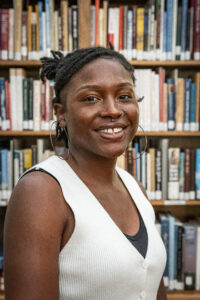This post is part of our blog series “Scholars Speak,” which features writing from our 2024 cohort of Preservation Scholars. Click the link to learn more about this donor-funded program that aims to increase the breadth of voices in the Texas historical narrative by placing students from underrepresented cultural and ethnic backgrounds in paid, 10-week long summer internship positions at the Texas Historical Commission.
Scholars Speak: Dr. James Lee Dickey (1893-1959): Champion of Medical Care

I have been fascinated with Black medical care since I started my journey in higher level education. The data I came across about the mortality rates for Black women, because of systemic insufficiencies in care, was staggering. Historically, hospitals and medical practices in general were designed to cater to a very homogeneous demographic, both from a gender and race perspective.
Representation is important. There is broad and overwhelming research that ethnically competent doctors and medical staff are key to well-rounded and potentially life-saving medicine for ethnic communities. This was especially true for the Black community in Williamson County in the early 20th century. When I started as an intern with the Friends of the Texas Historical Commission, I was excited to be able to work on my own project. So, I decided to bring light to Black healthcare across Texas in the 20th Century. This research with the Beyond the Markers project has exposed me to many excellent, caring, and trailblazing physicians. Dr. James Lee Dickey, one of the only practicing Black doctors in Williamson County in the 20th century, worked as one of these wonderful physicians.
Dickey, a native of Waco, Texas was born in 1893. He attended Tillotson College before going to Meharry Medical School, graduating in 1921. In the same year Dickey arrived in Taylor, Texas with his wife Magnolia. One of Dickey’s goals was to combat the disparate rates of disease amongst Black Americans in Taylor. Ailments like tuberculosis, typhoid, and infant diarrhea all plagued the rural Black community in the area. Dickey acted and showed results. For instance, in 1933, rates of typhoid fever, a potentially fatal bacterial infection, rapidly increased in rural Taylor. Many African Americans worked as sharecroppers and were unable to afford the cost for clean city water, so they borrowed from a local ranch. This water, unsafe for consumption, spread the sickness and many were left without proper treatment. Dr. Dickey noticed a spike in typhoid and talked with city officials, explaining to them the link between typhoid and the ranch water. His advocacy made a great difference, and officials authorized the opening of fire hydrants. Families came out with buckets, filled them with water from the hydrants, and took them home. Dickey also began to treat willing patients of the infection, making house calls and walking through the mud to get to those in need.
Eventually Dickey realized that he needed a space to treat more patients, so he bought an empty rooming house at 401 Bland Street and renovated the space into what would become the Dickey Clinic. Dr. Dickey did remarkable work at the clinic. He and a staff of predominantly Black nurses offered critical care to the Black folks of Williamson County. Dickey treated patients with venereal diseases, offered free prenatal care, and helped to nearly eliminate tuberculosis and cases of infant diarrhea amongst African Americans in Taylor. In 1952, his service to the community granted him Taylor’s Citizen of the Year, a very rare feat for a Black man in the Jim Crow South.
Dickey, more than just a doctor, worked as a humanitarian and an advocate of African American progress. He provided care to Black patients in a time when segregation, and the color line affected many walks of life for the community. Dickey had little worry for profit and fostered a space of inclusivity changing the lives of African Americans in Taylor. James Lee Dickey is a critical figure in Texas history, and everyone should know his story.